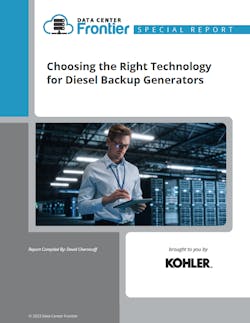Top-Level Issues to Consider When Selecting Backup Generator Technology
This launches our article series on how to choose the right diesel backup generator technology.
We live in a world where concerns for the environment, preserving the future, and long-term sustainability are driving technology decisions every day. Keeping those issues top of mind when determining the right choice for backup power generation for a data center might seem like over-thinking the issue. But the choices aren’t as simple as “I need a quality diesel generator system” any longer. From supply chain issues to operational requirements, the business of back up diesel power generation has seen its own changes that allow new technologies, regulations, and a focus on environmental issues begin to define the players in the field.
What Are the Issues You Face When Selecting the Right Technology for Your Needs?
There are a number of top-level issues that should be considered when selecting the technologies you demand from your backup power generation system. Some are those that you should demand from any supplier, while others are items and technologies specific to the diesel power generation market. In any case, they should all be considered when making your purchasing decisions.
Supply Chain
One of the most significant realizations during the pandemic crisis was the impact of supply chain issues in previously unexpected ways. Even with the normal extended period of time between ordering and deploying multi-megawatt scale diesel generators for data centers, the impact of supply chain issues on the availability of the generators resulted in time to deployment delays that were usually not accounted for.
When you consider all the points in the supply chain that were impacted, from basics as simple as the availability of raw materials, to manufacturing delays, to logistics and transportation issues, it shouldn’t come as a surprise that issues cropped up when all phases of the production and acquisition of the hardware were impacted. If anything, this highlighted the need to work with top-tier equipment providers. The more control a vendor has over its supply chain, the more accurate its information as to product availability and delivery dates. This can be especially true when it comes to avoiding quality control issues. A rush to find alternative providers at the component level can lead to a reduction in overall quality. Vendors who have a detailed view and control over their acquisition and production process are often less impacted by even industry-wide supply chain issues and tend to make better business partners.
Resliency and Uptime
It almost goes without saying that you get what you pay for with diesel generators. Higher quality equipment will be better built and have higher uptime and greater resiliency. And remember, this doesn’t apply to just the generator, but all of the ancillary equipment, as well, from the transfer switches to the cooling system.
Of course, regardless of the equipment, keeping up with the recommended maintenance schedule is a requirement. Backup power generators aren’t monolithic blocks and following the required maintenance for all of the components, from the belts to the starting batteries, is necessary to have a reliable and resilient system. Proper training for on-site technicians or contracts with the equipment provider can assure that you are addressing any potential maintenance issues and aren’t surprised by an issue when the system is needed for operation.
For maximum resiliency and uptime, physical redundancy makes sense. N+1 or 2N operations can provide that extra level of security in guaranteeing a redundant power source. Not all facilities require this level of redundancy, but if expectations exist that there will be any extended outrages requiring the data center to run on its backup power source, the adage “one is none, two is one” clearly applies. Any organization that has survived an extended power outage after a natural disaster has had firsthand experience of this.
Don’t forget the role that sizing plays in overall reliability. When building a data center, you can select a backup power supply that meets worst case scenario conditions or build the infrastructure in a way that additional backup capacity can be added as needed. A design that allows effective scalability provides a broader range of resiliency. Over provisioning your backup resource, aside from not being cost effective, can cause problems as generators are rarely efficient when running at low loads, which can also lead to long term maintenance issues.
Sustainability and Environmental Impact
The use of diesel backup generators for data centers is one of the most commonly noted factors when complaining about the sustainability and environmental impact of data center installations. While they might be the most economically efficient solution for backup power, the complaints of both air and noise pollution from large diesel generator installations are valid ones. And while alternatives are being developed, it is unlikely that diesel power generation solutions will be supplanted, especially for existing installations. What this means is that operators need to make sure that they are looking for the most environmentally sound solutions in the selection process for diesel backup power.
This means looking for the most efficient generators packaged in ways that reduce their impact on the environment, meaning that the generator enclosures need to also be a significant part of the decision process. From the outsider point of view it can be surprising exactly how much the role of the generator enclosure plays in a number of factors that impact selection criteria. For example, you need an enclosure that can be effective in reducing the noise level of operating diesel engines while not impacting the necessary airflow for efficient operation. At the same time, the enclosure needs to be designed in such a way that any maintenance that needs to be performed isn’t limited by accessibility to the power generation system. The enclosure also needs to protect the generators from the environment, preventing issues such as inclement weather, and ideally even major weather events such as hurricanes, when backup power will most likely be required, from impacting power generation.
Other environmental and sustainability issues encountered include the carbon emissions of diesel generators, as well as other pollutants traditionally associated with diesel power, primarily nitrogen oxides and particulate matter. Changes in fuel and the series of EPA tier requirements regulating diesel emissions have led us to more efficient and sustainable diesel power production. Since backup generators are run on a regular basis to test and guarantee availability in on demand situations, much of the environmental impact can be mitigated by a technology known as “no-load” maintenance.
Download the full report, Choosing the Right Technology for Diesel Backup Generators, featuring Kohler, to learn more. In our next article, we'll explore the concept of no-load maintenance.
About the Author




